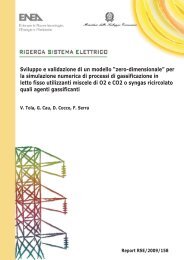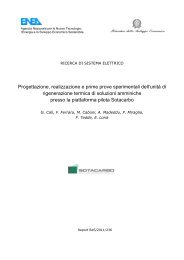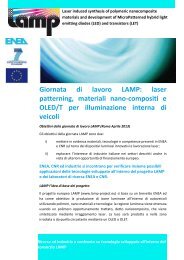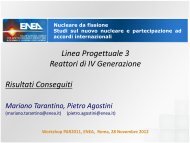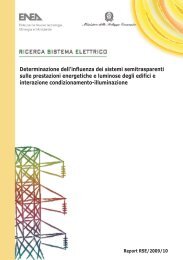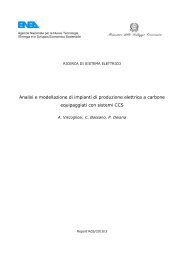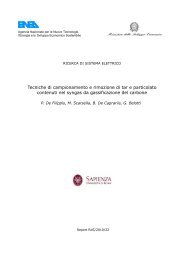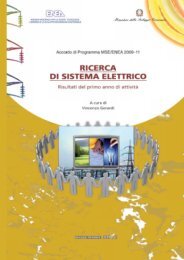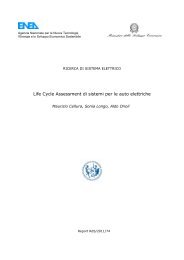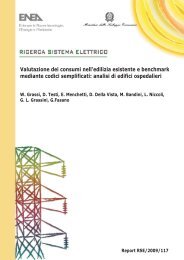Sviluppo di moduli batterie litio-ioni per avviamento - Enea
Sviluppo di moduli batterie litio-ioni per avviamento - Enea
Sviluppo di moduli batterie litio-ioni per avviamento - Enea
You also want an ePaper? Increase the reach of your titles
YUMPU automatically turns print PDFs into web optimized ePapers that Google loves.
Consumo: < 80mA (esercizio), < 200 μA (stand-by).<br />
Numero <strong>di</strong> LMU supportate: 32 (256 celle in serie).<br />
Data I/O: 8 ingressi/uscite relè configurabili, capacità 10 A.<br />
Controllo <strong>di</strong> carica: PWM, CAN, Analogico.<br />
Protez<strong>ioni</strong>: corto circuito, <strong>di</strong>s<strong>per</strong>sione, guasto all’isolamento, eccesso <strong>di</strong><br />
carica/scarica, tem<strong>per</strong>atura (minima e massima).<br />
Bus dati: CAN (<strong>per</strong> interfaccia con sistemi esterni), RS232 (<strong>per</strong><br />
interfaccia PC <strong>per</strong> <strong>di</strong>agnostica).<br />
Tem<strong>per</strong>atura <strong>di</strong> esercizio: -40°C ÷ +105°C.<br />
Tem<strong>per</strong>atura <strong>di</strong> storage: -50°C ÷ +125°C.<br />
Grado <strong>di</strong> protezione: IP61.<br />
Figura 24 – Scheda BMCU<br />
Principali caratteristiche tecniche della scheda <strong>di</strong> monitoraggio (LMU)<br />
La scheda LMU è responsabile del monitoraggio e controllo a livello <strong>di</strong> cella: misura la tensione<br />
delle singole celle e la tem<strong>per</strong>atura del modulo <strong>batterie</strong> <strong>di</strong> appartenenza e della scheda stessa,<br />
fornisce la circuiteria <strong>per</strong> il prelievo <strong>di</strong> energia dalle singole celle in carica durante il<br />
bilanciamento. E’ capace <strong>di</strong> monitorare con continuità da 3 1 fino ad 8 celle e fino a 32 schede<br />
LMU possono essere connesse in serie e controllate da un’unica scheda master BMCU<br />
(quest’ultima rileverà automaticamente il numero <strong>di</strong> schede LMU ad essa connesse,<br />
rimuovendo la necessità <strong>di</strong> settaggio manuale: ciò rende le <strong>di</strong>mens<strong>ioni</strong> e la tensione del pacco<br />
regolabili aggiungendo o rimuovendo celle molto velocemente e semplicemente. Si riportano <strong>di</strong><br />
seguito le specifiche principali della scheda LMU.<br />
Dimens<strong>ioni</strong>: 100x160 mm.<br />
Alimentazione: 4,5 ÷ 24 VDC.<br />
Consumo: < 50mA (esercizio), < 100 μA (stand-by).<br />
Numero <strong>di</strong> celle supportate: da 3 ad 8 in serie.<br />
Accuratezza <strong>di</strong> misura della tensione: < ±10mV.<br />
Accuratezza <strong>di</strong> misura della tem<strong>per</strong>atura: ± 3°C.<br />
Corrente <strong>di</strong> bilanciamento delle celle: 0 ÷ 2 A, regolata da PWM usando resistori<br />
sulla scheda.<br />
Tem<strong>per</strong>atura <strong>di</strong> esercizio: -40 ÷ +105°C.<br />
Tem<strong>per</strong>atura <strong>di</strong> storage: -50 ÷ +125°C.<br />
Grado <strong>di</strong> protezione: IP61.<br />
1 Il numero minimo <strong>di</strong> celle è giustificato dal fatto che la scheda LMU si alimenta dalle celle: sono necessari almeno 6<br />
VDC <strong>per</strong> alimentare la scheda LMU.<br />
36



